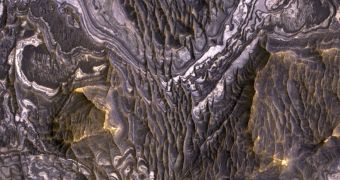Data collected by the High Resolution Imaging Science Experiment (HiRISE) camera on the NASA Mars Reconnaissance Orbiter (MRO) fill the pages of the January special issue of the renowned scientific journal Icarus. More than 21 research papers documenting various features of Mars have been published in this edition, all of them hinting at a great diversity of processes that took place on the Red Planet over billions of years. The action of wind, water, air, ice, and other such factors has been thoroughly documented, and now the conclusions that various teams drew from HiRISE images are showcased, Space Fellowship reports.
Among the most interesting works published in Icarus, experts include studies concerning the action of water on the planet's surface. For example, some images show evidence that acidic water once flew on Mars, as revealed on plateaus lying right next to the largest canyon system on the planet. These areas are filled with light-toned layered deposits, which seems to suggest that the region was altered at very low temperatures. Such deposits can form, for instance, when volcanic rock is subjected to the action of running, liquid, acidic water, and this appears to have been the case too, researchers say.
Astronomers and planetary scientists also scanned the region known as the Elysium Planitia, and discovered some interesting facts about the rocks making it up. They determined that the flood-lava flow that created the area was the youngest to have ever occurred on Mars, and also that the formation covered an area about the size of the state of Oregon. In addition, it would now appear that the flow was put in place during the course of a single eruption, and not several, successive ones. According to estimates, this happened in just a few weeks, during the course of a non-stop, violent eruption.
New HiRISE observations also helped geologists make sense of some of the most disturbing shapes found on Mars. In far-southern regions, fan- and spider-shaped patterns in the ground sent researchers in a frenzy when they were first discovered. Recent images proved that they were actually formed as carbon dioxide was vented from beneath the surface of the ice, causing the terrain above to collapse in these particular shapes. The entire process is founded on the seasonal CO2 cycle that takes place at the southern Martian pole, when whole spreads of the chemical evaporate.
The HiRISE instrument is operated by the University of Arizona in Tucson (UAT). It was built by the Ball Aerospace & Technologies Corporation, in Boulder, Colorado. It is one of the six highly advanced scientific instruments on the MRO. The orbiter itself, which has been experiencing some issues lately, is managed by scientists at the Jet Propulsion Laboratory (JPL), in Pasadena, California. The Flagstaff, Arizona-based US Geological Survey (USGS) Astrogeology Science Center prepared the special issue of Icarus, and participated with two guest editors, and expertise on many of the published papers.

 14 DAY TRIAL //
14 DAY TRIAL //